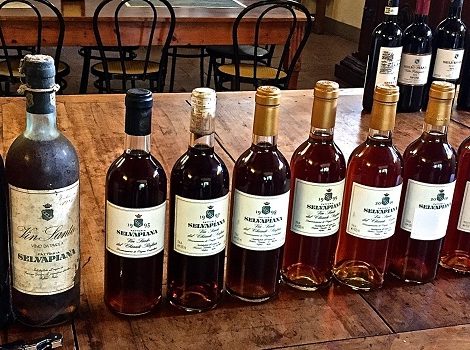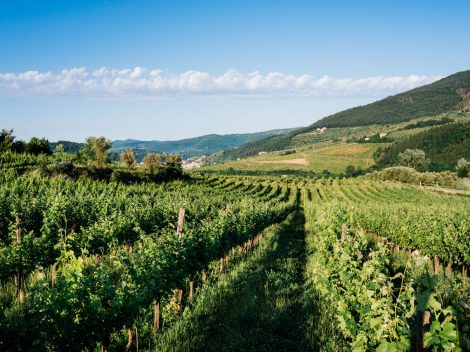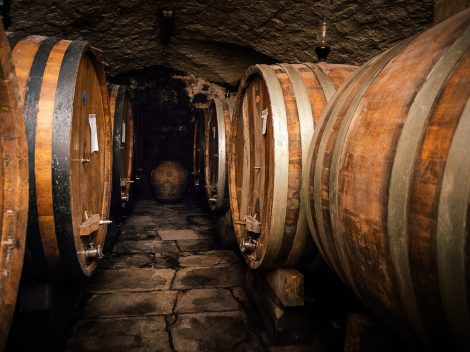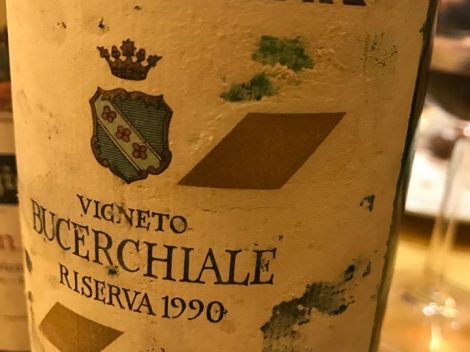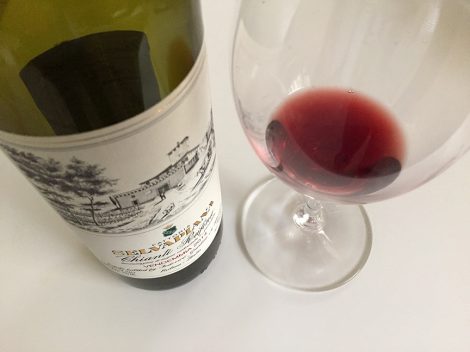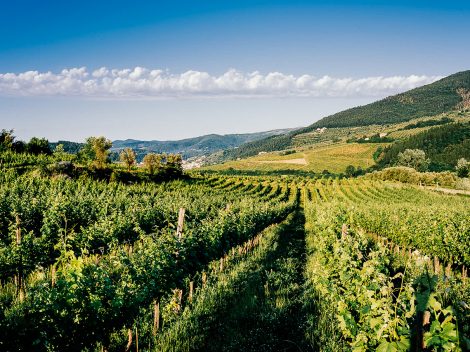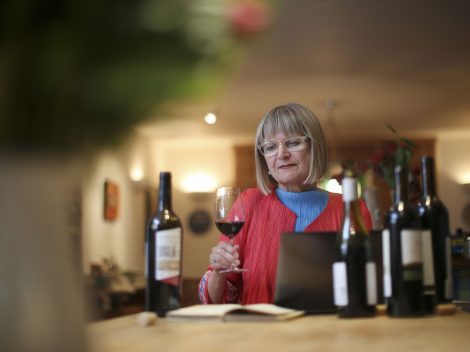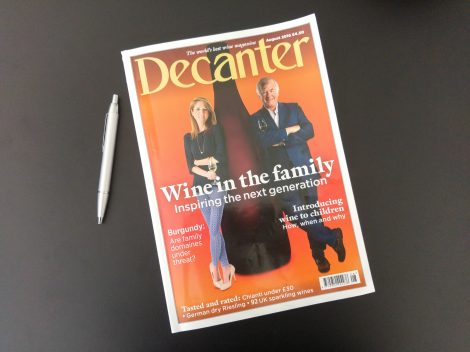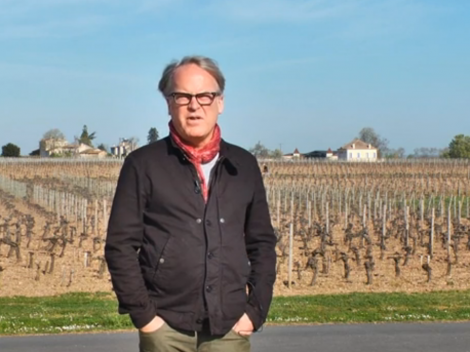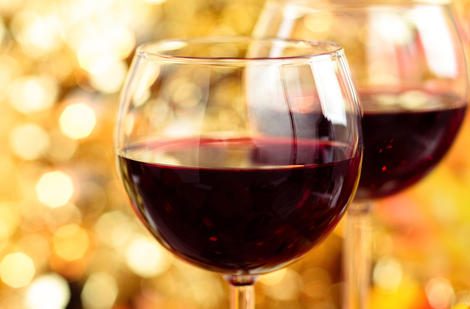Selvapiana
Bryce Wiatrak featured Selvapiana in his Vin Santo article for Vinous Media
Bryce Wiatrak featured Selvapiana in his Vin Santo article for Vinous Media. Selvapiana The furthest north I traveled in my exploration of Vin Santo was to Chianti Rùfina to visit Federico Giuntini at Selvapiana. I can hardly characterize an entire sub-region based solely on one producer, nonetheless for a wine as unpredictable as Vin Santo. But, Selvapiana’s Vin Santos show more finesse and less body than their more southerly relatives (including those of Giuntini’s cousin Roberto Stucchi Prinetti at Badia a Coltibuono), similar to how one might generally compare Chianti Rùfina with Chianti Classico. After harvest around the end of September, Giuntini hangs the grapes from bamboo rods to dry for five months. The wine spends six years in caratelli, made mostly from either French or Slavonian oak, but a few chestnut barrels remain. Giuntini misses the cherry caratelli, and would love to bring some back into the program. I had the distinct pleasure of tasting through ten vintages of Selvapiana’s Vin Santodel Chianti Rùfina. Giuntini tracked down bottles dating back to 1958 for this tasting. One quality that binds Selvapiana’s Vin Santos is a crystalline purity of flavor, unmatched by any of the other producers I visited. One hundred-percent Trebbiano, these are wines driven by acidity, untethered from their viscosity. In many respects, this is a more subdued variant of Vin Santo, more slender than many of its relatives. Beginning with the 2007, you immediately enjoy an orange juiciness that runs through the wine. It flashes all the other more savory notes associated with Vin Santo– garden herbs, buttered popcorn – but it’s never bogged down by them. It shows a rewarding viscidity without carrying a heaviness of flavor. The 2006 and 2003 are where Selvapiana’s Vin Santos really hit their stride. This extra time in bottle composes the wine into a Mozartian precision. Every note in these Vin Santos finds its way into a perfect contrapuntal balance. The 2006 demonstrates an iridescent, cold minerality that grows broad through a medley of fresh white peaches, nectarine and apricot. The 2003, too low in alcohol to achieve DOC recognition, boasts an even more expressive nose and unfolds slowly on palate. The acidity is so laser-like and long, it seems to finish far after the rest of the wine. Moving to the 2001, the Vin Santo at this age starts to imbue a more medicinal character – rosemary, quinine, sage. The fruit takes a backseat to these more earthly flavors. Federico explains that 2001 was a hotter vintage and he replaced many caratelli that year, which combined could account for the dramatic difference between this and the 2003. The 1999 treads a similar path as the 2001, the herbaceousness contributing a slight astringency. By 1998 we find a much darker Vin Santo, both in its hue and flavor profile. Notes of beeswax and bittersweet chocolate collide with the taste of wild mushrooms and ash. The 1997 seems to be aging at a tad slower pace. It’s a few shades brighter – caffè latte, rather than straight-up espresso. The 1993 shows darker still. Oxidation takes its toll on the Vin Santo, condensing the wine into a mass of burnt cashew, coffee grounds and cocoa beans. The astringency is undeniable, but it’s not an altogether unpleasant one. If anything, it’s an intellectually engaging experience tasting these lighter-bodied Vin Santos at this stage in their development, as was also the case with San Giusto a Rentenanno. While more unctuous renditions may never achieve the clarity of expression that defines these two producers’ Vin Santos, they nevertheless seem to outlive them, protected by that extra layer of insulation. Clusters hanging in the appassitoio at Selvapiana The last two Vin Santos in the flight, 1985 and 1958, are both in the winter of their lives, but reveal a fascinating window into the narrative of this product. Both vintages long before the creation of Vin Santo del Chianti DOC, these wines are labeled vino da tavola. The 1985 really embodies an amontillado character – saline and rich, like a perfect beef consommé. While the wine ends with a bitterness instead of that thrilling acidity, the butter flavors start to dance with more vitality than any of its younger brethren. The 1958 has lost much of its body by this age, whittled down to a salty skeleton. Much like its bottle, the wine shows a certain patina and tastes sprinkled with sawdust, the imbibable equivalent of walking into a cluttered antique shop, the dusty air illuminated by scattered rays of golden light. Federico defines these two wines as the old-style of Vin Santo, meant for the immediate consumption of friends rather than extended time in a collector’s cellar. So, they may not prove fully indicative of what will come of the more recent releases. What a treat it is, though, to taste history like this. Read the full article here: http://www.antoniogalloni.com/articles/tuscany-s-mysterious-self-making-vin-santo-mar-2016
Certificate of L’Impronta in the new edition of the Guide “WINE OF ITALY 2017
With pleasure we publish the certificate of L'Impronta that Go Wine has acknowledged to Selvapiana on the new edition of the Guide "WINE OF ITALY 2017 - Guide to the Wine Tourist."
Antonio Galloni / Vinous press clips from December 2016
Antonio Galloni / Vinous press clips from December 2016
An old Rufina in perfect shape. By Luciano Pignataro Blogs
By Luciano Pignataro Blogs (http://www.lucianopignataro.it/a/toscana-1990-tre-chianti-casanova-neri/118941/). Toscana 1990: tre Chianti e il Casanova di Neri Ci si ritrova alla Galleria di Poggibonsi tra Giovani Igp. Qui Carlo Macchi ci trascina per farci mangiare mare in mezzo al Chianti prima di una epocale riunione di Garantito Igp con Stefano Tesi, Angelo Peretti, Andrea Petrini, Lorenzo Colombo e Roberto Giuliani. Da anni uno dei pochi segnali di aggregazione in web. Sarà per non siamo figli della rete ma delle reti. Fatto sta che non c’è niente di più bello che degustare vini in questo modo: Antichi Toscani dala cantina di Macchi raffreddato. Un atto di generosità enologica senza precedenti:-) Ci troviamo così questi quattro vini e ce li godimo tutti. Incredibile ma vero, a distanza di tanti anni quello che ci è piaciuto più di tutti è il Chianti Classico Riserva Selvapiana, un antico Rufina in perfetta forma, fresco, tonico, meraviglioso sul cino con ancora in serbo tante cose da regalare. Nonostante appartenga ad un’altra era geologica rispetto alla sua attuale evoluzione, paradossalmente il Casanova di Neri è invece quello che, pur affascinante e buono, è quello che ci ha rilassato di meno il palato. Troppo esuberante e materico per i Giovani Igp. A metà strada gli altri due, verso il Rufina il Ser Lapo di Castello di Fonterutoli. In direzione del Casanova di Neri il Monsanto del Poggio. Conclusioni Non siamo nei mitici anni ’80, ma sicuramente impressione bere questi rossi a distanza di tanti anni e vedere come hanno tenuto bene nel tempo. Note di frutta, freschezza, legno ben digerito come si diceva qualche anno fa, nessuna esasperazione per stupire inutilmente il palato. Spesso per godere il vino bisogna aspettarlo nel tempo. Ma la domanda finale è stata un po’ inquietante: quanti rossi del decennio successivo avranno questa capacità di affascinare chi li stappa? Ne parliamo tra 20 anni:-)
Selvapiana Chianti Rufina 2014: good to the last drop (3 days later)
Just a quickie this very busy Thursday morning as the food and wine world seems to be finally getting back online. I opened the above bottle of Selvapiana Chianti Rufina 2014 four nights ago and drank two glasses with dinner over the last three evenings. And man, the very last glass, which I paired with rotisserie chicken and a baked potato (dressed simply with extra-virgin olive oil, Kosher salt, and freshly cracked pepper), was the best of all. I was just blown away by how vibrant and how varietally expressive this wine was. It wasn’t just hanging in there on the third night. It was actually even better than the previous evening. What a great wine and what a great value… All things considered, for the price (around $17 in my market) and quality and availability throughout the U.S., this is one of my all-time top wines. Definitely in my top 5 for greater Chianti. It also paired gorgeously with Tracie P’s Neapolitan-style ragù on nights one and two. That’s all I have time for today… more tomorrow… Thanks for being here. Posted on January 12, 2017 by Do Bianchi - https://dobianchi.com/2017/01/12/best-chianti-classico-rufina/
Excellent scores by Monica Larner of Wine Advocate/RobertParker.com for Selvapiana wines
Excellent scores by Monica Larner of Wine Advocate/RobertParker.com for Selvapiana wines in her article on the Chianti Rufina: Italy, Tuscany: Chianti Rufina (And Why the Region Should Consider a Name) Only a 30-minute drive northeast of Florence, Chianti Rufina is one of Italy’s most overlooked wine regions. Wild and rustic, Sangiovese vines (with other notable Tuscan grapes such as Trebbiano, Malvasia, Canaiolo and Colorino) are planted along the flanks of wooded hills with steep vertical drops and well-draining soils. Temperatures are a few degrees lower here on average compared to neighboring wine regions resulting in crisp and streamlined wines with delicate floral and berry nuances. The landscape is pristine and untouched. It recalls the best of Tuscany from a time before Tuscany was such a popular tourism destination. Despite its low profile, Chianti Rufina is indeed one of the oldest wine regions in Italy. Just a little while ago, it celebrated its 300th anniversary along with neighboring regions Chianti Classico, Pomino, Carmignano and Valdarno di Sopra. On September 24, 1716, the Granduca di Toscana Cosimo III drew the official lines that would set the lines for these storied appellations. Over the course of those three centuries, Chianti Rufina would emerge as one of the most productive wine hubs in Italy with a distribution network firmly in place across all major overseas markets. Its fortune would later decline and the region would become largely sidelined by the more prolific and sophisticated production power of Chianti Classico just next door. The Chianti Rufina appellation surrounds the historic railroad exchange at Pontassieve that once connected transportation lines between northern and southern Italy. Sangiovese-based wines were packaged in the iconic straw-wrapped flask, or fiasco, that would become a veritable symbol of Italian enology back when vino italiano was associated with easygoing, food-friendly wines to wash back with a plate of spaghetti and meatballs served on a checkered tablecloth at your favorite Italian-American trattoria. Millions of bottles were produced and distributed by rail across Europe and onto distant lands. Fruity, simple and acidic, the ruby-colored wine offered many Americans their first taste of Italian wine. In 1971, when the first super Tuscan wine Tignanello was produced by Piero Antinori, the hay-wrapped flask suddenly became a symbol of an old and outdated wine style. Chianti Rufina still has yet to fully recover from this image crisis, despite the impressive work and the important investments in the region today. On my tasting trip to Chianti Rufina during this special 300th anniversary year, I enjoyed the opportunity to exchange views with the producers and appellation officials. Our conversation focused on ideas that would help to re-launch and re-brand the region and distinguish it from Chianti Classico. How can Chianti Rufina get its groove back? This was the question on most people’s minds. Among the many ideas floated, one sticks out in my mind as an absolute no-brainer. There is a growing movement that favors changing the region’s name from Chianti Rufina to simply Rufina. It is my strong opinion that this easy name modification would bring many important benefits to the region. By shedding the name “Chianti,” the following objectives would be achieved: A more concrete identity for Rufina could be achieved by avoiding confusion with the Chianti Classico appellation and the larger denomination named Chianti. Rufina, Chianti Classico and Chianti would be viewed as three separate and independent wine regions. The name Rufina favors greater territorial identity. Rufina is a township in the province of Florence that includes the wine hub Pontassieve. Rufina is associated with a pristine and pure style of Sangiovese that stands apart from the denser and more extracted style of wine sometimes favored in Chianti Classico and elsewhere. The local blending formula reflects strict Tuscan traditions with other indigenous red and white grapes. Carmignano was once part of the greater Chianti region and was known as Chianti Carmignano. It changed its name from Chianti Carmignano to Carmignano and continues to enjoy the benefits of this change today. In other words, a successful model has already been set. Rufina could easily revive the celebrated hay-wrapped fiasco that was once at the heart of its international identity. If done with intelligence, Rufina could recreate this special indigenous packaging (that once required a cast of working women known as fiascaie to hand-assemble straw bottle exteriors) with the same stylistic ingenuity as the restyled Fiat 500 or the Vespa 50cc. I love the idea of a Rufina retro resurgence and I think consumers would, too. The bottom line is that Chianti Rufina’s wines are distinct from Chianti Classico, Chianti and the other appellations formally part of the greater Chianti territory in Tuscany. Its identity could be further developed with a simple name change. It seems to me that this would be a good place to start.
October 2016 Selvapiana tasting by jancisrobinson.com
October 2016 Selvapiana tasting by jancisrobinson.com: Selvapiana Located in Rufina, Selvapiana has been owned by the family of Francesco Giuntini since 1827. In medieval times, Selvapiana was one of the watch towers along the Sieve river, built to protect the city of Florence to the north-east border. During the Renaissance, it became a summer residence for noble families and Florentine bishops. Winemaker Francesco Giuntini, who was among the first Tuscan producers to make a Riserva wine from 100% Sangiovese, was born on the estate and now runs the property, with consultant Franco Bernabei. The estate covers 245 ha (605 acres), of which 54 are under vine and the rest olive groves and woods. The vineyards primarily face west, though Selvapiana's prized Bucerchiale vineyard is south-west facing. The vineyards are situated at an elevation of 150-200 m (492-656 ft), with a clay and limestone soil. Selvapiana 2014 Chianti Rufina - 16.5 Stelvin or cork. Light ruby with brick edges. Perfumed with sweet cherry fruit. Lively and with a fine chalky texture. Refined texture, chalky but compact. Dry but not in the least drying. Classic restraint. GV (JH)13% Drink 2016-2020 Selvapiana, Vigneto Bucerchiale Riserva 2012 Chianti Rufina - 16.5+ Single vineyard. Bricky garnet. Inviting mature undergrowth aroma but still with sweet, vanilla-edged red fruit. Very fragrant. A little meaty on the palate, some spice, fine grained though still with some firmness to the texture. Dry, chalky finish. (JH)14.5% Drink 2016-2022 Selvapiana, Villa di Petrognano 2012 Pomino - 16 Selvapiana rent 6 ha of vines from the Fattoria di Petrognano. Mid ruby. Plenty of spice here, tangy red and black fruit. Firm, chewy but lifted by very nice freshness. Straightforward but persistent. Just starting to show some mature, dried-fruit flavours on the finish. (JH) 14% Drink 2016-2019
Selvapiana Chianti Rufina 2014, first very good review from Decanter
Decanter August Issue Selvapiana Chianti Rufina 2016 Tasting by Michael Garner, Emily O'Hare, Monty Waldin.
Selvapiana Chianti Rufina 2013 tasting notes by James Suckling
A fresh and clean wine with dried berry, light chocolate and mineral aromas and flavors. Medium to full body, crisp finish. A liveliness and length that Rufina delivers. Lovely brightness. Drink now. Score: 92 Country: Italy Region: Tuscany Vintage: 2013 Date: October 29th, 2015
Los Angeles Times recommened Selvapiana Rufina 2013
Irene Virbila, wine columnist for Los Angeles Times, recommended both Selvapiana and Coltibuono in today’s article highlighting six Chiantis to pair with a variety of dishes. Please see below for a link and extracted text. Thanks! http://www.latimes.com/food/dailydish/la-dd-chianti-wine-20151028-story.html 6 Chiantis to drink now. Think wine for pizza, even Middle Eastern food Chianti can be a great wine to drink with pizza, spicy meatballs and even Middle Eastern food. If you find yourself longing for pasta fagioli, pappardelle in wild boar sauce, or arista -- Tuscany’s roasted pork loin scented with rosemary and garlic -- maybe it’s time to lay in some Chianti. The Sangiovese-based red from Tuscany goes, of course, with Tuscan food. But it’s also versatile enough to work with California, Mediterranean and even Middle Eastern cuisines. Need a pizza wine? Or one to go with spiced meatballs? Try a Chianti Classico or a Chianti Rufina. And don’t worry about buying too much of a good thing. A year or two more in bottle will only improve this Italian red. In Tuscany, Chianti is very much an everyday wine, poured from a pitcher into tumblers. We've collected a handful of Chiantis, some priced for every day, others not so much, but all are worth laying in for fall and winter drinking. 2013 Fattoria Selvapiana Chianti Rufina Selvapiana is one of the best estates in Chianti Rufina (a subzone of Chianti), and consistently turns out first-rate Sangiovese-based reds. A deep ruby in color, the 2013 Selvapiana Chianti Rufina is a classic, tasting of dried cherries and plums, mushrooms and herbs. A great everyday red to keep on hand for pasta nights and grilled skirt steak or pork chops. Some of the excellent 2012 is still around, too. Look for it at K&L Wine Merchants in Hollywood, Manhattan Fine Wines in Manhattan Beach, the Wine Country in Signal Hill and the Wine House in Los Angeles. From $16 to $17.

